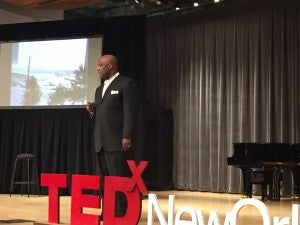TEDxNewOrleans: Examining Recovery and Resiliency in New Orleans 10 Years Post-Katrina
 This Tuesday a group of nearly 200 people gathered at the Peoples Health New Orleans Jazz Market for a day of talks from a variety of community and business leaders, artists, academics and others as part of the first-ever TedxNewOrleans. While the perspective of each talk varied, resilience and recovery of Greater New Orleans since Hurricane Katrina served as a unifying theme. The talks were spirited, inspirational and truly painted a picture that New Orleans “didn’t just come back, we got crunk” as colorfully stated by Michael Hecht of GNO Inc. in closing the day. Videos of the events are forthcoming, but in the meantime, here are some of the highlights:
This Tuesday a group of nearly 200 people gathered at the Peoples Health New Orleans Jazz Market for a day of talks from a variety of community and business leaders, artists, academics and others as part of the first-ever TedxNewOrleans. While the perspective of each talk varied, resilience and recovery of Greater New Orleans since Hurricane Katrina served as a unifying theme. The talks were spirited, inspirational and truly painted a picture that New Orleans “didn’t just come back, we got crunk” as colorfully stated by Michael Hecht of GNO Inc. in closing the day. Videos of the events are forthcoming, but in the meantime, here are some of the highlights:
- Rod West, Entergy’s Executive Vice President and Chief Administrative Officer, painted a visceral picture of the days following Katrina, from thinking we had dodged a bullet to being told there were white caps on Canal Street to then having to inform his employees that their homes were underwater and ask that they get to work literally repowering New Orleans.
- The Executive Director of 504ward, “New Orleans’ home base for young talent,” Jessica Shahien explored the city’s transition and her organization’s role in turning the notorious brain drain into a brain gain and how young professionals are flocking to live in New Orleans.
- Troy Simon detailed his journey from being twelve, illiterate and living in the Lower 9th Ward at the time of Katrina to being a senior at Bard College, a nationally-recognized speaker on education reform and meeting President and Mrs. Obama at the White House.
- SMG Executive Vice President Doug Thornton discussed the recovery of the Superdome – particularly his team’s frantic struggle to get it functional in time for the 2006 Saints vs. Falcons opener – and its status as an economic engine for New Orleans and symbol of resiliency.
- Through a series of conceptual drawings, Aron Chang of Waggoner and Ball Architects provided an overview of how the Mississippi River built its delta over time and encouraged all of us to “draw” our visions for what the future of our region might look like.
- A former marketing executive at Mignon Faget and Sucré and creative director of the Muses parade, Virginia Saussy colorfully recounted the months following Katrina when laughing through tears was critical and how she responded to a CNN story suggesting New Orleans cancel its first post-Katrina Mardi Gras.
- From education to healthcare to public housing, Chief Administrative Officer of the City of New Orleans Andy Kopplin discussed how government has been a force of disruptive change since Katrina.
- Actress and musician Kimberly Rivers Roberts recounted how Katrina empowered her to change her attitude from “I can’t” to “I can,” opening up a world of opportunities, including a documentary she filmed “Trouble the Water” receiving an Academy Award nomination.
What struck me in hearing these people speak about resilience, recovery, of “I can” attitudes and disruptive innovations, is that these principles can and have been applied in the fight to save Louisiana’s coast. In addition to the undeniable economic and infrastructural progress made around the Greater New Orleans region that these talks highlighted, over the last 10 years, we have also made significant gains in restoring our coast including:
- Passing game-changing legislation that has provided us with a science-based blueprint (Louisiana’s Comprehensive Master Plan for a Sustainable Coast) and funding (the RESTORE Act) for addressing our coastal land loss crisis.
- Closing storm surge super highway MRGO and developing a plan to restore this ecosystem.
- Implementing early restoration projects, such as the Mid-Barataria Land Bridge and Marsh Creation Project, Lake Hermitage Marsh Creation, and other early restoration projects that have already made headway in building land and preventing further loss.
The progress made over the last decade is proof that working together we can address the most significant crisis currently facing our state. Louisiana continues to lose a football field of land every hour. Our best offense to protect New Orleans and Southern Louisiana from future storms is a strong defense, and with all due respect to our Saints, New Orleans has no better defensive line than a restored coast. For that reason, our coalition advocates for a Multiple Lines of Defense Strategy – anchored by a restored coast working in concert with the $14.5 billion dollar improved levee system and water management innovations like the Greater New Orleans Urban Water Plan. These pieces of the pie fit together to protect our communities, industries and culture and serve as a model for similar communities around the world.
As we look ahead, in order to ensure the long-term protection and resiliency of our region, we need to continue to fund and implement the Coastal Master Plan, particularly the 19 priority projects in it identified by our coalition as having the greatest potential to restore our coast. Ten years later, it’s clear that New Orleans has bounced back (and even gotten a little crunk). Let’s recognize, learn from and celebrate these successes, but let’s also acknowledge the work that remains and get to it.

